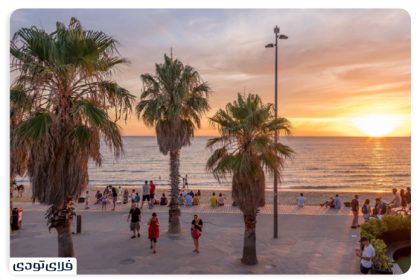A trip to Istanbul means visiting various tourist attractions in addition to shopping, entertainment and dining; But the question is always here, where should we start touring in this city? Definitely, the Hagia Sophia Mosque in Istanbul is one of the first Sights of Istanbul that you must visit on your trip to this city. Just like the Eiffel Tower in Paris and the Parthenon in Athens, Hagia Sophia is a symbol of the city and is very important for Istanbul. Continue with tourism magazine Fly Today Come along to learn more about this spectacular and important attraction of Turkey.
Getting to know Hagia Sophia in Istanbul
Hagia Sophia is not just a mosque, but one of the most valuable works of architecture in the world; A building that was destroyed twice in history and rebuilt each time, and finally turned into a mosque from Hagia Sophia in Istanbul. Its name was changed many times and finally Hagia Sophia remained.
Hagia Sophia is a place where Byzantine and Islamic architecture creates a wonderful combination and you rarely see the same combination in another historical work. From the column that people believed heals to the 40 windows that create a mystical aura in the nave, all of them are wonders of this work. You have to see Hagia Sophia to understand why it is registered in the UNESCO list and is so important. Maybe by seeing the beauty and wonders of Hagia Sophia, you will understand why about 3 million people visit this work every year?!
Where is Hagia Sophia?
Hagia Sophia Mosque is located in the Sultanahmet neighborhood in the European part of Istanbul. Sultan Ahmed is one of the most touristic neighborhoods in Istanbul, with various hotels and sights around it.
Address: Istanbul, Sultan Ahmed neighborhood, Hagia Sophia square, Hagia Sophia mosque

How to go from Taksim Square to Hagia Sophia Mosque?
The distance between Taksim Square and Hagia Sophia Mosque is about 3 kilometers and you can travel it in the following ways:
- The cheapest way to go from Taksim Square to Hagia Sophia Mosque It takes 15 minutes to use a tram. You can take Tram T1 line from Katabas tram station to Sultan Ahmed neighborhood.
- Taxi is the fastest way to go to Hagia Sophia from Taksim Square and it only takes 8 minutes.
- There is also a direct subway line from Taksim Square in Istanbul to Hagia Sophia. All you have to do is take a ride at Taksim Maidan metro station and go to Sultan Ahmed neighborhood.

Istanbul Hagia Sophia ticket price and visiting hours
Visiting time of Hagia Sophia in Istanbul: Every day from 09:00 to 17:00
Note that you cannot visit this work during prayer times. For more information, you can visit the Ayasofiya Mosque website.
Important points of visiting Hagia Sophia
- To visit the interior of Hagia Sophia, you must take off your shoes in the carpeted area.
- Men and women should wear appropriate clothing (do not wear too short or too tight clothing).
- Women must wear a headscarf before entering the mosque. Of course, they are also given a scarf at the entrance of the mosque.
- Photography is allowed, but you cannot take pictures of people worshiping.
- Try to visit Hagia Sophia Mosque during the day to have the best experience of visiting this building.
- On weekends and Fridays at noon, this place is very crowded with locals.
Architecture of Hagia Sophia The inspiration for the Blue Mosque in Istanbul
Hagia Sophia was an important church in the capital of the Byzantine Empire, which later became a mosque for the Ottomans. Hagia Sophia in Istanbul was built between 532 and 537 AD with the inspiration of Byzantine art and architecture. This style later inspired many other Ottoman mosques such as the Blue Mosque in Istanbul.

From this point of view, Hagia Sophia is considered an important historical work that boasts a combination of Byzantine and Islamic architecture. You can see the Islamic architecture in the minarets, calligraphy and altar of this historical work.
The general structure of Hagia Sophia is designed almost in a square shape. There are three corridors in this building that are separated by columns and each one has a beautiful gallery of mosaics. Mosaics and calligraphy are an important part of the architecture and design of this work, which we will talk more about later.
History of Hagia Sophia Mosque in Istanbul From Byzantine to Ottoman
Hagia Sophia is a 1500-year-old building and is a place where both Christians and Muslims have worshiped. Hagia Sophia was originally built as a church, and after the fall of the Byzantine Empire in 1453, it became the Hagia Sophia Museum in Istanbul, Turkey. At first, this work was called The Great Church because of its large size; But after the Ottoman war, it was renamed Hagia Sophia. Let's take a look at the history of Istanbul's Hagia Sophia Mosque, this outstanding piece of architecture.
Basic structure: The construction of a church for Orthodox Christians began when Istanbul was known as Constantinople. During the Byzantine Empire, Constantine I ordered the construction of this church. Istanbul was the capital of the Byzantine Empire at that time and Orthodoxy was known as its official religion. This great church burned down in 404 AD amid the riots that arose in Constantinople and was lost forever.

The first reconstruction: This work was rebuilt in 415 AD by Emperor Theodos II. At this time, a church was again built on the ruins of the previous church, but it was again badly damaged in the conflict and chaos that ensued.
Second reconstruction: Hagia Sophia suffered a lot of damage over time, but in the 6th century, Justinian restored it. This church was rebuilt 3 times and the last restoration took place in 537 AD. From that time until today, the building of this building has remained almost as you see it. Many mosaic paintings of the face of Christ, Holy Mary and Byzantine kings were added to Hagia Sophia during this period. Even today, these mosaic paintings are an important part of Hagia Sophia.
When and by whose order was Hagia Sophia turned into a mosque?
In 1453, by order of Sultan Muhammad II, the use of this church was changed. After Sultan Muhammad conquered Istanbul, he ordered the church's paintings to be covered and the first Friday prayer to be held there. Minaret, pulpit and altar were also added to Hagia Sophia during this period.
Reconstruction during the time of Sultan Selim: During the reign of Selim II (1566-1574), the architecture of the mosque underwent changes. A Turkish architect added parts such as new minarets, the sultan's lodge and a tomb for Selim II to this mosque and gave it a new face.

Hagia Sophia after the Ottoman battle: Most of the designs on the original mosaics were changed by Islamic calligraphers after the Ottoman war. During this period, an altar and 4 minarets were also added to the mosque.
Hagia Sophia in the 20th century and the presence of Atatürk: Different parts of Hagia Sophia were built during different governments and have been continuously changing. Finally, in 1943, by order of Kemal Atatürk, the president of Turkey, this building was used as a museum and became a tourist attraction. Until 2020, this work was managed by the Turkish Ministry of Culture under the title of Hagia Sophia Museum.
Hagia Sophia Mosque and Erdoğan's order: In July 2020, at the order of Turkish President Recep Tayyip Erdogan, the doors of Hagia Sophia reopened to the public as a mosque for worship. Currently, this outstanding work, with the use of a mosque and a museum, is in the list of the most famous tourist attractions in Istanbul.
Construction materials of Hagia Sophia, Istanbul From Anatolia to Africa
Emperor Justinian wanted to create a symbol for the entire Byzantine Empire, and he did everything he could. He built a large dome, which is rare in the world, and added marble columns to the building to represent its grandeur in the minds of the people. The emperor even collected materials for the construction of this mosque from different regions. The marble floor of Hagia Sophia was brought from Anatolia, which is now in eastern Turkey and Syria. The bricks of the walls and parts of the floor also arrived in Istanbul from North Africa.

Spectacular parts of Hagia Sophia
Hagia Sophia Mosque is a religious, political and artistic center from the Byzantine period. From the time you set foot in the Hagia Sophia Mosque, you need an hour and a half to visit all the details of this work, from its architecture to the tombs, etc.
The second largest dome in the world in Istanbul
The main nave of the Hagia Sophia mosque has a large dome, which is the second largest dome in the world after St. Peter's Church in Rome. This amazing dome with a diameter of 33 meters is located at a height of 55 meters from the ground. Two semi-domes are built on both sides of it, one in the altar and the other in the main entrance.
40 windows are built all around the dome, which let a dazzling light into the nave during the day. Beautiful calligraphy covers the entire interior of the dome. The semi-circular walls and tall columns that support this dome have created a wonderful image. This building becomes more spectacular with the image of the dome and columns that are stacked on top of each other.
Hagia Sophia dome and church were built by two architects named Anthemius and Isodorus. It is interesting to know that, unlike the dome of the Parthenon temple, which never shook, the dome of Hagia Sophia collapsed due to an earthquake in 558 AD, and it was rebuilt with stronger walls.

Columns from the Temple of Artemis!
Apart from the dome, the columns of Hagia Sophia mosque in Istanbul attract the attention of every viewer. This mosque has 140 marble columns. You must have heard the name of the Temple of Artemis in Ephesus, which is considered one of the seven wonders of the world. It is interesting to know that some of the Hagia Sophia marbles were brought from the Temple of Artemis. Also, the 8 crimson columns of Hagia Sophia, which show the era of the Byzantine Empire, came from Egypt. The columns in Hagia Sophia are not ordinary columns, but each of them is considered a valuable historical and artistic work.

A pillar that heals!
There is a column in the northwest part of this building, which is known as “Arzoo Column” and has become sacred among people over time. But what is the story of this column? During the time of the Eastern Roman Empire, people believed that this pillar would heal! According to legends, one day Emperor Lustianus, who had a severe headache, rested his head on this pillar and his pain was relieved. People believed that if they put their finger in the hole of this pillar and touch their body, they will be healed!
Hagia Sophia mosaics
A part that should not be missed when visiting Hagia Sophia in Istanbul is the golden mosaics and paintings left over from the Byzantine era. These mosaics are the first parts of the architecture of this valuable work, only a part of which can be seen today. One of the most important remaining paintings on the mosaics is the image of the Holy Mary with Christ at her feet. Above the southwest entrance of the mosque, there is a mosaic of the image of the Holy Mary with Constantine, the first Byzantine emperor, and Justinian I.

Hagia Sophia calligraphy and Islamic art
As we said, after the Ottoman battle, Hagia Sophia was converted into a mosque. Hence, its interior design changed to a great extent. Many calligraphers entered the mosque to perform Islamic art and covered various parts of previous works.
The calligraphies of Hagia Sophia Mosque are an important part of it today. These calligraphies can be seen in the corners of this work and their golden color completely attracts attention. All these calligraphies were done by the order of three Ottoman kings, Muhammad II, Ahmed III and Mustafa II.

The Imperial Gate, where the emperors entered the church
The age of this gate goes back to the 6th century and it is the largest gate of Hagia Sophia with a height of 7 meters. The material of the door frame is made of bronze metal and the door itself is made of oak wood. The emperor and his family used this entrance to enter the church. The height of this door is higher than the other doors of the building and you can easily recognize it.
Sultan Mahmud I Library
The library built by Sultan Mahmud I in Hagia Sophia Mosque is unique in terms of architecture. This library was considered a rich collection and at that time many people were employed in it. Sultan Mahmud visited this library several times and gave it various gifts. In 1968, the books in this section were transferred to the Sulaymaniyah library.

Tomb of Sultans in Hagia Sophia The king who designed his tomb before his death!
There are 5 tombs belonging to Ottoman sultans and their families in Hagia Sophia Mosque. These tombs are located in a small place in the southeast corner of this monument:
Mausoleum of Muhammad III, the 13th Ottoman King: Sultan Muhammad III was the first person who took over the administration of his army after Sultan Suleiman the First. His fourth son, Ahmed, built the Blue Mosque in Istanbul.
Sultan Selim II, the eleventh Ottoman king: He was not a successful person and was not interested in running the government and military affairs. His mausoleum is one of the most beautiful mausoleums in Istanbul, which he ordered to be designed by “Sinan Memar” before his death.
Murad III, the twelfth Ottoman king: The last minarets of the Hagia Sophia Mosque were built by the order of this Ottoman king. His wife and several children are buried with him in this tomb.
Mustafa I and Ibrahim, the fifteenth and eighteenth Ottoman kings: After Mustafa I, the last tomb belongs to Ibrahim, the 18th Ottoman king. Besides Mustafa and Ibrahim, 17 other people have been buried.

Is it necessary to book a guided tour to visit Hagia Sophia?
You can go to Hagia Sophia by yourself or visit this historical monument with a tour. These tours have a guide and give you a lot of information about this mosque. Usually these guided tours are available at the entrance of the mosque courtyard, but our suggestion is to use the tours that take you to several important attractions in Istanbul.

Hotels near Hagia Sophia
To Istanbul hotel reservation And near Hagia Sophia, look for hotels in Sultan Ahmed neighborhood. This neighborhood is a tourist area with many hotels; It even has beautiful historical buildings that have been converted into hotels and have the style of the Ottoman period.
The best hotels near Hagia Sophia:

For more information, we recommend the article The best hotels in Taksim Square, Istanbul read the
Sightseeing places around Hagia Sophia
You can reach the following attractions from Hagia Sophia with just a two-minute walk:
- Sultan Ahmed Mosque
- Topkapi Palace
- Basilica Cistern, or the Istanbul Cistern
- Khorram Sultan bath and fountain
- Istanbul Gülhane Park

History is touched in Hagia Sophia
The Hagia Sophia Mosque in Istanbul has gone through many ups and downs in history and today it has become a world work. Visiting this mosque creates a different feeling in the viewer and takes you from the Byzantine period to the Ottoman Empire. A 1500-year-old history that you only need an hour and a half to read! So don't delay and now Cheap plane tickets Buy yours so your first stop in the city is the Hagia Sophia Mosque.
Travel to Türkiye with Istanbul tour
As you know, the cost of traveling to Turkey includes the purchase of plane tickets, hotel reservations, travel insurance, transfers, meals, sightseeing, etc.; But you can buy Istanbul tourReduce your costs. Also, buying a tour will help you to experience the best of Istanbul in a short period of time, along with visiting Hagia Sophia. The best time to book a tour is in spring and autumn.
What do you think about Hagia Sophia? Share your feelings about this work with us.
Frequently asked questions about the Hagia Sophia Mosque in Istanbul
Where is Hagia Sophia in Istanbul?
Hagia Sophia Mosque is located in the Sultanahmet neighborhood, the European part of Istanbul and a short distance from Topkapi Palace.
How to go to Hagia Sophia Mosque in Istanbul?
You have to enter the tram line from Taksim square and get off at Sultan Mohammad station, after that you will reach the mosque with a short walk.
When did Hagia Sophia become a mosque?
After the fall of the Byzantine Empire in 1453, this building was turned into a mosque by the order of Sultan Muhammad II.
The best hotels near Hagia Sophia which are
White House Istanbul Hotel, Poem Hotel and Istanbul Suites are among the best hotels near Hagia Sophia.
RCO NEWS


















